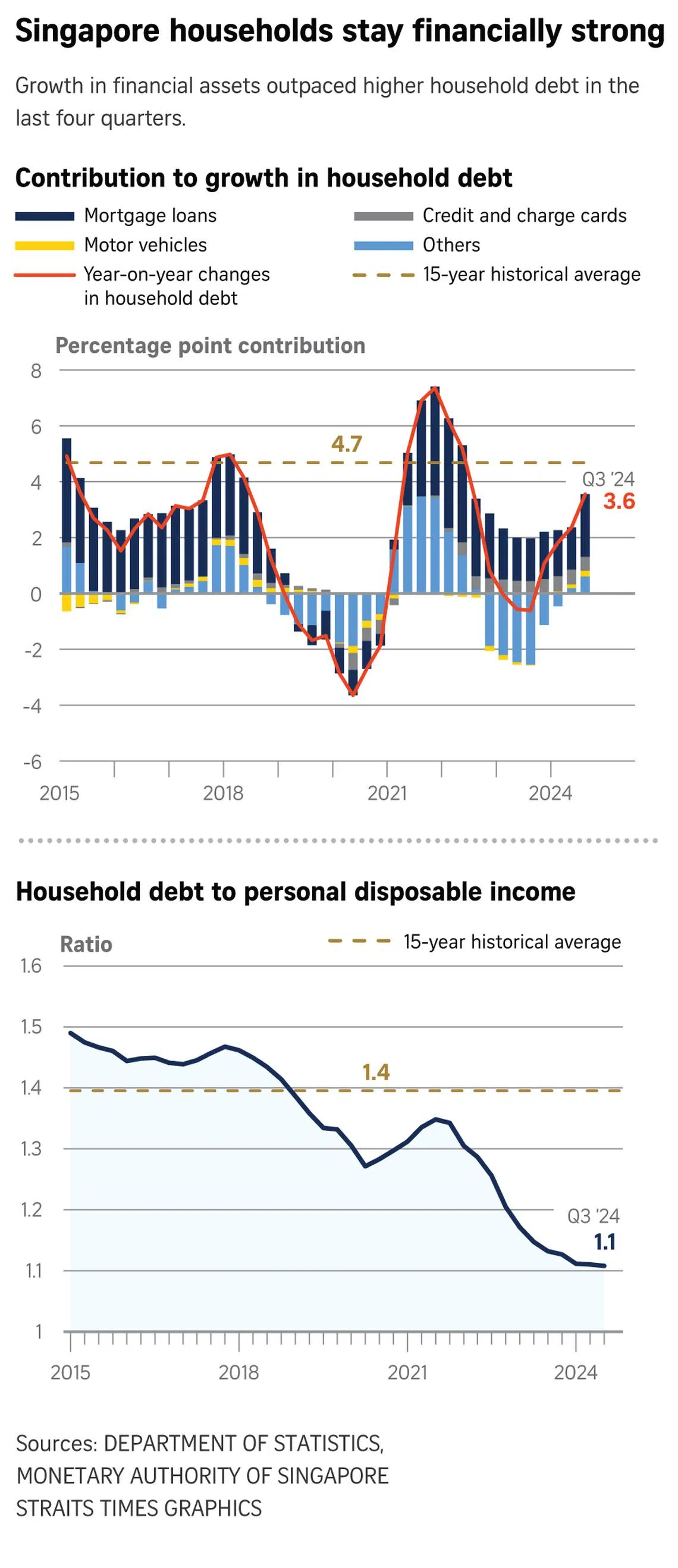Singapore households’ debt up, but financial assets grew faster: MAS
Sign up now: Get ST's newsletters delivered to your inbox

The ratio of household debt to personal disposable income is also down for the 12th quarter in a row.
PHOTO: ST FILE
Follow topic:
SINGAPORE - The debt of households in Singapore may have risen in the past year, but their financial assets such as cash and stocks grew at a faster pace, so they can withstand pressures, said the central bank.
This is because income growth has been healthy and has outpaced debt accumulation, the Monetary Authority of Singapore (MAS) said in its annual financial stability review on Nov 27.
Household debt in the third quarter of 2024 was up by 3.6 per cent year on year, with mortgage loans the key contributor.
About 75 per cent of household debt comprised housing loans backed by property collateral.
Aggregate household net wealth grew in the first six months of 2024, rising by about 9 per cent year on year to nearly $3 trillion in the third quarter.
Liquid assets like cash and deposits continued to exceed total liabilities. They made up about 20 per cent of total assets as at the third quarter of 2024, the report said.
In fact, household debt fell to 1.1 times personal disposable income, or after-tax income, in the third quarter. The figure is less than the 15-year historical average of 1.4 times, and has declined for the 12th straight quarter, MAS said.
Mortgage loans
It noted that mortgage rates, or the interest paid as part of a monthly home loan, have declined, so Singapore households’ ability to service their debts remained strong, especially as income growth has been stable.
Even though new housing loans were up in the third quarter of 2024 to $210.2 billion, outstanding housing loans edged up only 1.6 per cent year on year to $224.3 billion in that quarter, as the rise in new loans was mostly offset by borrowers paying down their existing mortgages.
Fixed-rate mortgage packages offered by banks have fallen to below 3 per cent in the first half of 2024, after peaking at 4.5 per cent at the end of 2022.
The central bank noted that the credit quality of housing loans remains strong, with the housing non-performing loans ratio staying low at 0.3 per cent as at the third quarter of 2024. The 10-year historical average is 0.4 per cent.
MAS said asset price volatility risk is expected to be contained as the private housing market has been stabilising,
In aggregate, prices rose by 1.6 per cent in the first three quarters of 2024, much slower than the 3.9 per cent increase in the same period a year ago.
MAS said the fall in new sales of private homes was partly offset by a rise in resale transactions. It added that over the past six months, private home transaction volumes have been picking up gradually.
The private rental market has also moderated from its peak.
“While the recent easing of domestic interest rates may have boosted market sentiments as developers resumed project launches, the macrofinancial outlook is subject to significant uncertainties arising from geopolitical conflicts and trade tensions,” warned MAS.

Personal loans and credit card debt
The review also said personal loans were 0.3 times personal disposable income in the third quarter of 2024. The ratio of personal loans to personal disposable income has been on a downward trend since the fourth quarter of 2021.
MAS said personal loans climbed by 5.1 per cent year on year in the third quarter of 2024, but the growth rate has remained below the historical average of 5.7 per cent.
When it comes to paying off credit-card or charge-card debts, MAS said almost all borrowers have been able to do so despite rising balances, led by robust growth in resident outbound travel and domestic retail sales.
The credit-card delinquency rate has remained low at less than 1 per cent.
MAS said rollover balances as a share of personal disposable income edged up to 2.4 per cent in the third quarter of 2024, but is still below pre-pandemic levels.
Around 18 per cent of total card holders have not paid off their balances in full over the past year – significantly lower than pre-pandemic levels.
Looking ahead, MAS said risks to the household sector are expected to be contained, given strong financial buffers, but it urged households to be prudent amid so much uncertainty.
“The easing of mortgage rates in the first half of 2024, accompanied by stable income growth, has bolstered households’ debt servicing ability, while the liquidity position of households has further improved,” the central bank said.
It added: “However, given the heightened geopolitical uncertainties and trade tensions in the macrofinancial environment, households should continue to exercise prudence in their financial management.”


